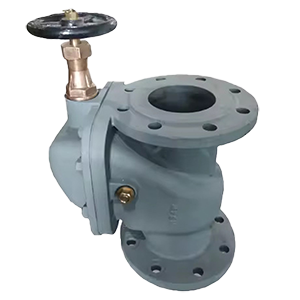This article will explore the structure, function, application, and industry relevance of Angle Type Storm Valves, providing shipbuilders, engineers, and operators with a thorough understanding of this specialized marine valve.
What Is an Angle Type Storm Valve
An Angle Type Storm Valve is a marine-grade combination valve that integrates a check valve and a manual shut-off valve into one compact 90-degree angular body. It is designed to be installed in overboard discharge lines—typically those associated with sewage, bilge, or drainage systems—to ensure one-way flow of liquids from the vessel to the sea, while preventing seawater from flowing back into the ship under backpressure or high seas.
The valve’s unique design ensures fail-safe operation in harsh marine conditions and enables fast manual isolation when needed, making it a critical element of a ship’s flood prevention system.
Construction and Working Principle
1. Angular Body (90° Type)
The valve body is designed at a 90-degree angle, allowing efficient fluid direction changes and making it ideal for installations in vertical or tight piping spaces, such as beneath decks or near hull penetrations.
2. Integrated Check Valve
At the core of the valve is a spring-loaded or gravity-assisted disc that functions as a non-return valve. This disc automatically opens when fluid flows from the ship toward the sea and closes tightly if external pressure tries to force seawater inward.
3. Manual Shut-Off Mechanism
A handwheel or lever allows manual actuation of the valve to completely block flow, enabling maintenance, emergency closure, or manual override of the check function.
4. Sealing and Seat Options
Storm valves are available with either metal-to-metal or soft seats (rubber or elastomeric), depending on the application and desired tightness of seal.
Key Functions and Advantages
| Function | Description |
|---|---|
| Backflow Prevention | Prevents seawater from entering internal systems during high tide or backpressure. |
| Discharge Control | Allows regulated discharge of waste, bilge water, or grey water overboard. |
| Manual Isolation | Enables system shutdown for maintenance or in emergency scenarios. |
| Space Optimization | 90° design reduces space requirements and piping complexity. |
| Corrosion Resistance | Made from bronze, stainless steel, or cast iron with protective coatings. |
Common Applications on Ships
-
①Black water systems (toilets, sewage)
-
②Grey water systems (showers, sinks, drainage)
-
③Bilge water discharge
-
④Galley and scupper drainage
-
⑤Overboard discharge piping
-
⑥Sanitary discharge lines
- ⑦Tank drains near the hull shell
Maintenance and Inspection
-
①Inspect disc and sealing surfaces periodically for wear or corrosion.
-
②Lubricate moving parts and threads of the manual operating mechanism.
-
③Check for smooth opening/closing of the check valve during routine discharge.
-
④Manually cycle the valve occasionally to avoid seizure.
-
⑤Replace seals if soft-seated valves show signs of leakage.
Compliance with Marine Standards
-
①DNV (Norway)
-
②ABS (United States)
-
③LR (United Kingdom)
-
④CCS (China)
-
⑤BV (France)
-
⑥RINA (Italy)
-
⑦KR (Korea)
Materials and Sizes
-
①Bronze – corrosion resistant and widely used in marine water systems.
-
②Cast iron or ductile iron – economical and robust.
-
③Stainless steel – suitable for high-corrosion areas or chemical discharge.
Standard sizes typically range from DN40 to DN250, but larger sizes can be customized depending on the vessel’s piping design.
Selection Tips
-
①Discharge medium (sewage, bilge, grey water)
-
②Piping configuration and space constraints
-
③Required certifications for classification society approval
-
④Valve seat material (metal or soft)
-
⑤Manual operation accessibility
-
⑥Corrosion resistance requirements
Post time: Jul-24-2025

